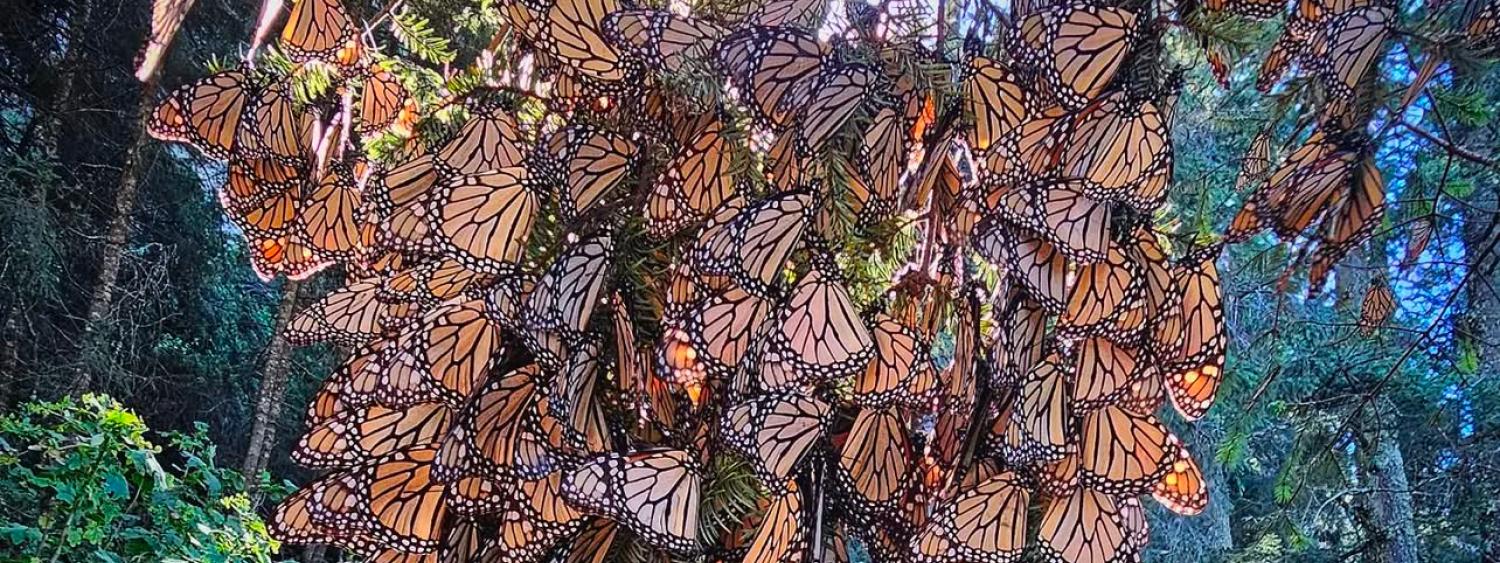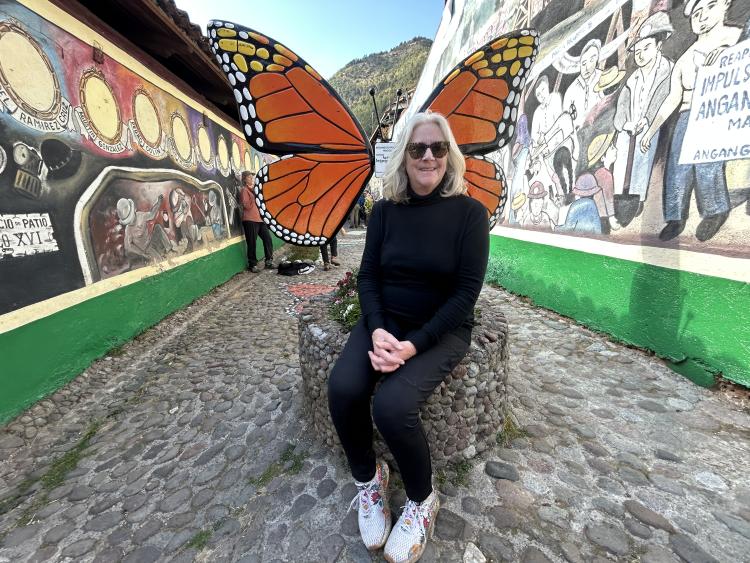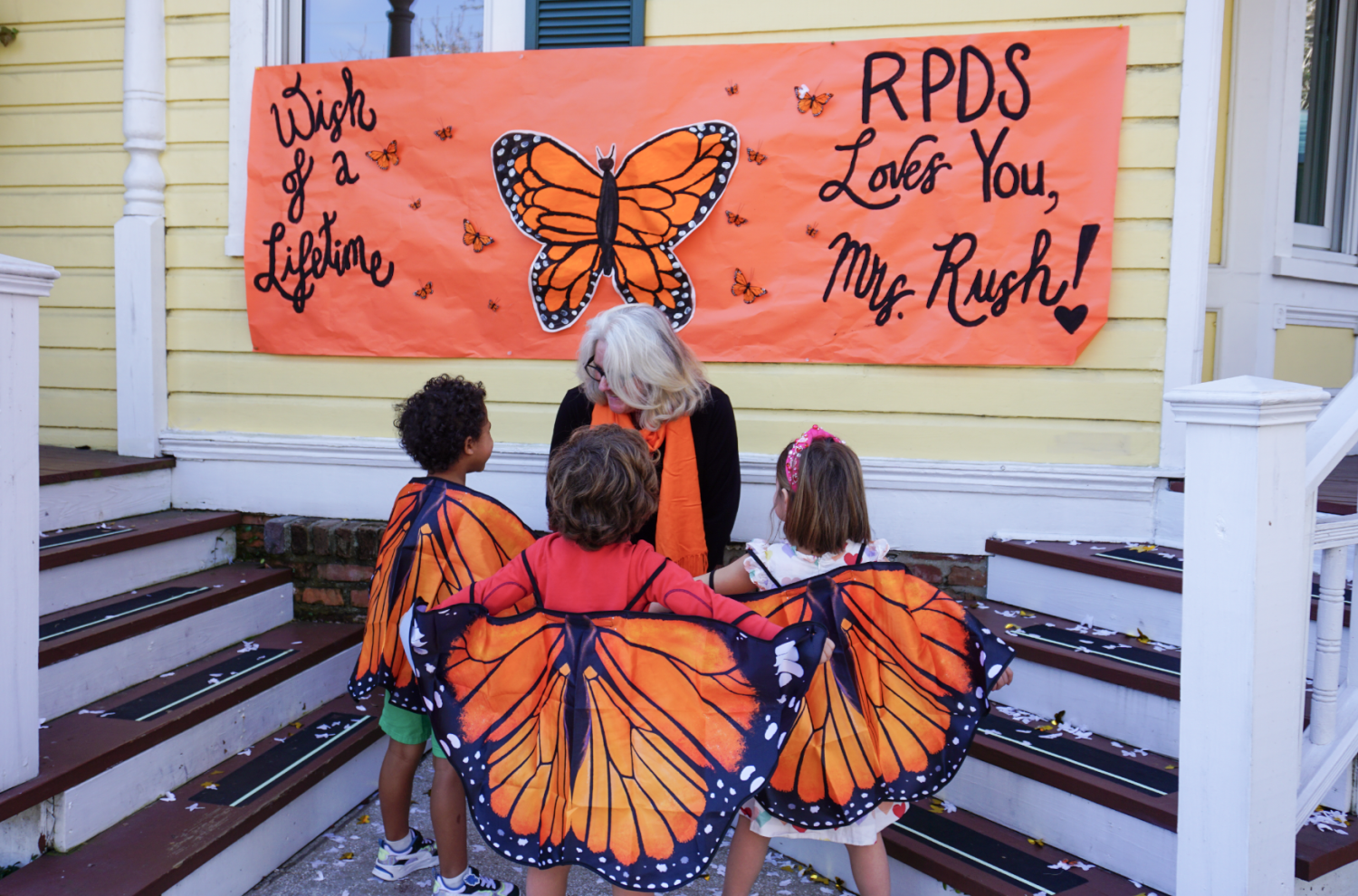The Butterfly Effect
How one education alumna is spreading her wings and sharing her passion for nature one butterfly at a time

In the rugged mountains of central Mexico, Peggy Campbell-Rush boarded an open pickup truck, rode on horseback, and hiked with a small group led by an internationally known conservationist to reach the awe-inspiring butterfly sanctuary. There, the air shimmered with millions of monarchs, delicate yet determined, filling the trees and sky. Some brushed against her. Others clung to branches like leaves. She had waited a lifetime for this moment.
“You're just walking through the forest, and then you come across it—it’s incredible,” she said. “They are everywhere.”
Each year, millions of monarchs make the epic 1,000-5,000-mile journey from as far North as Canada to overwinter in one of only five sanctuaries in North America. Many take off again in spring to return home.
Trip of a lifetime

In February, Campbell-Rush received a coveted “Wish of a Lifetime” grant, designed to “spark hope and joy in the hearts of older adults,” to witness the monarch migration.
To her, monarchs are more than insects— they symbolize transformation, tenacity and the magic of nature.
It’s amazing to me that these butterflies, weighing less than an ounce, fly 3,000 miles and arrive in Mexico unscathed. It’s just a miracle." — Peggy Rush-Campbell
With 50 years of experiences in education, the CU Boulder alumna (MEdu'81) has spent decades raising butterflies and teaching about their conservation. Researchers estimate the population of monarchs in Mexico has decreased by around 80% since the 1990s, according to the the Xerces Society for Invertebrate Conservation.
Campbell-Rush’s love for the orange-and-black creatures and their conservation began early. Her education began at home in New Jersey, where her mother, a physical education teacher and coach, filled their yard with bird feeders and butterfly gardens. Campbell-Rush spent summers chasing monarchs with a net, careful not to harm them. It sparked a lifelong curiosity about their life cycles and migration.
“It’s amazing to me that these butterflies, weighing less than an ounce, fly 3,000 miles and arrive in Mexico unscathed,” she said. “It’s just a miracle.”
Spreading her wings
Like the monarchs, Campbell-Rush’s life and career have covered a lot of ground. She began teaching kindergarten in New Jersey in the 1970s before moving to Boulder, where she worked in restaurants while pursuing her master’s in education.
Her restaurant colleagues introduced her to Semester at Sea, and instead of returning to the classroom, she circled the globe by ship in 1983, returning years later as a senior administrator for the program.
“Once you travel, you just can’t stop,” she said. “If you get the opportunity, you have to do it.”
Beyond her voyages, she taught in London, launched school gardens, raised butterflies with students, and taught lessons with nature as co-teacher.
- Plant milkweedandnative nectar plants, for caterpillars and mature butterflies, respectively.
- Garden wisely and avoid pesticides which harm intended and unintended insects.
Follow Peggy’s lead, spread the word about the importance of monarch butterflies and their conservation.
Source: https://www.fws.gov/sites/default/files/documents/2024-12/monarch-fly-into-action-factsheet.pdf
As a teacher, administrator, professional development leader, and author of seven books, Campbell-Rush continues to mentor new educators with warmth and wisdom.
“The first thing I tell new teachers is: ‘Thank you for being a teacher,’” she said. “I also recommend they get three mentors: one mentor that will help with all big questions and another mentor that maybe is in the school already who can give you the behind-the-scenes information.
“The third mentor is you, because you could go to all the professional development, but you have to consider if it’s something that fits you and your classroom.”
Recently, she was selected as a Fulbright Education Specialist, helping develop civil rights curriculum tied to South Africa’s post-apartheid era and the U.S. Amistad Act.
As well-traveled and accomplished as she is, Campbell-Rush’s sojourn to the butterfly sanctuary in Mexico was, indeed, a trip of a lifetime. One condition of her grant is to pay it forward.
Emerging from the chrysalis
Now, Campbell-Rush lives surrounded by milkweed and memories. This spring, she cared for 74 caterpillars. She also hosts events and inspires neighborhood kids to give milkweed as birthday gifts. She stays connect with former students, mentors new teachers, and visits schools to teach about monarchs’ conservation and resilience.
Resilience means much to Campbell-Rush, a stage 3 breast cancer survivor who taught bald, wearing a custom cap that read “No Hair Day,” a spin on “Bad Hair Day.” The illness taught her to receive help as graciously as she gives it.
“As women, we’re often givers, and I found it hard to be a receiver,” she said. “But people get as much from giving as you do from receiving. That’s wonderful.”
Just as monarchs return each spring to the gardens where they were raised, Campbell-Rush continues to receive so much inspiration from them as she marvels at nature’s delicate balance. She hopes others will too.
“As a teacher, I did all kinds of things to bring nature to the kids,” she said. “They get that wide-eyed look, and you just wait for that. It's so satisfying. Hopefully, in their lives, they're conservationists, who respect wildlife and the world around us.”


